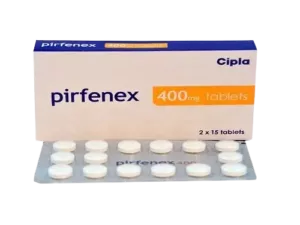PIRFENIDONE
Buy Pirfenidone Tablets Online
Important Medical Notice: Pirfenidone is a prescription medication that requires medical supervision. Always consult with a healthcare provider before starting any medication.
When someone receives a diagnosis of idiopathic pulmonary fibrosis (IPF), the journey ahead can feel overwhelming. Among the treatment options available, pirfenidone tablets have emerged as an important medication that can help slow the progression of this challenging lung condition.
Showing all 2 results
What is Pirfenidone and How Does it Work?
Pirfenidone is a prescription medication specifically designed to treat idiopathic pulmonary fibrosis, a progressive lung disease where scar tissue forms in the lungs over time. The medication belongs to a class of drugs called anti-fibrotic agents, which means it works to reduce the formation of scar tissue in the lungs.
Pirfenidone is an agent used for the treatment of idiopathic pulmonary fibrosis (IPF), and it has been shown to help slow down the progression of this condition. The drug works by targeting multiple pathways involved in the scarring process, helping to preserve lung function and potentially improving quality of life for patients living with IPF.
Understanding Pirfenidone Uses
The primary use of pirfenidone tablets is for treating idiopathic pulmonary fibrosis in adults. Pirfenidone is used to treat idiopathic pulmonary fibrosis, and this remains its main approved indication. IPF is a serious condition where the lung tissue becomes thick and stiff over time, making it increasingly difficult to breathe.
Research has shown promising results for pirfenidone in managing IPF. The result of the meta-analysis showed that pirfenidone significantly reduces the risk of disease progression by 30%. This means that for many patients, pirfenidone can help slow down the worsening of their condition, potentially giving them more time with better lung function.
The medication is typically prescribed when a patient has been diagnosed with mild to moderate IPF. It’s important to understand that while pirfenidone can slow disease progression, it’s not a cure for IPF. The goal of treatment is to help maintain lung function for as long as possible and improve the patient’s overall quality of life.
Pirfenidone Dose and Administration
Getting the right pirfenidone dose is crucial for the medication’s effectiveness and to minimize side effects. The maximum total daily dose of pirfenidone is 2403 mg/day, but patients don’t start at this full dose right away.
The typical dosing schedule involves a gradual increase over time. Most patients begin with a lower dose that’s gradually increased over several weeks to allow the body to adjust to the medication. This stepped approach helps reduce the likelihood of side effects while ensuring patients receive the full therapeutic benefit.
Pirfenidone tablets are usually taken three times daily with food. Taking the medication with meals helps improve absorption and can reduce stomach-related side effects that some patients experience. It’s important to take the medication at roughly the same times each day to maintain consistent levels in the body.
Patients should never adjust their pirfenidone dose without consulting their healthcare provider. If someone misses a dose, they should take it as soon as they remember, but if it’s close to the time for the next dose, they should skip the missed dose and continue with their regular schedule.
Pirfenidone Cost Considerations
The cost of pirfenidone can be a significant concern for many patients and their families. The medication is available under the brand name Esbriet, and pricing can vary considerably depending on insurance coverage, pharmacy location, and available assistance programs. For those wondering how much does pirfenidone cost, the answer depends on several personal and systemic factors.
For patients with commercial insurance, there are often assistance programs available. Eligible commercially insured patients may pay $0 per monthly prescription with a maximum savings of $500 per fill. These programs can significantly reduce out-of-pocket costs for qualifying patients.
Several factors influence the overall cost of pirfenidone treatment. Insurance coverage plays a major role, and many patients find that prior authorization is required before their insurance will cover the medication. This process involves the healthcare provider submitting documentation to the insurance company explaining why the medication is medically necessary.
For patients without insurance or those facing high out-of-pocket costs, patient assistance programs may be available. These programs are designed to help eligible patients access their medication at reduced costs.
Additionally, some pharmacies offer discount programs that can help lower the cost of pirfenidone tablets.
Important Safety Information
Like all medications, pirfenidone can cause side effects, and patients should be aware of what to watch for during treatment. One of the most important safety considerations is sun sensitivity. Pirfenidone can make your skin sensitive to the sun and the light from sunlamps and tanning beds. You could get a severe sunburn.
Patients taking pirfenidone should use sunscreen with a high SPF, wear protective clothing, and avoid prolonged sun exposure. This precaution is especially important during the summer months or when traveling to sunny destinations.
Other common side effects can include nausea, stomach upset, dizziness, and fatigue. These effects are often most noticeable when starting the medication or increasing the dose, and they may improve as the body adjusts to the treatment.
Regular monitoring by healthcare providers is essential during pirfenidone treatment. This typically includes periodic blood tests to check liver function, as the medication can occasionally affect liver enzymes. Patients should report any unusual symptoms to their healthcare provider promptly.
What to Expect During Treatment?
Starting pirfenidone treatment is often a gradual process that requires patience and close communication with the healthcare team. The medication typically begins to show its effects over several months rather than immediately, so patients shouldn’t expect rapid changes in their symptoms.
During the first few weeks of treatment, the focus is usually on managing any side effects and ensuring the patient can tolerate the medication. The healthcare provider will gradually increase the dose according to a specific schedule, monitoring how well the patient responds.
Regular follow-up appointments are crucial during pirfenidone treatment. These visits allow the healthcare provider to assess how well the medication is working, monitor for side effects, and make any necessary adjustments to the treatment plan. Patients will typically have lung function tests periodically to track the progression of their condition.
Patients need to maintain realistic expectations about pirfenidone treatment. While the medication can help slow disease progression, it doesn’t reverse existing lung damage. The goal is to preserve as much lung function as possible and maintain quality of life for as long as possible.
FAQs
Medical Disclaimer
This information is for educational purposes only and does not constitute medical advice. Always consult with qualified healthcare professionals for the diagnosis and treatment of medical conditions. All medication purchases require valid prescriptions from licensed medical practitioners.


